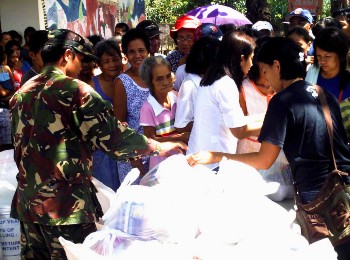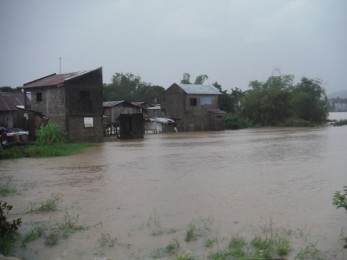About 1 result/s
-
Volume 5, Issue 1, August 2023
The Philippines is highly exposed and vulnerable to tropical cyclones (also known as typhoons), which caused over ₱352 billion worth of losses and damages to agriculture between 2000 and 2021. The study focuses on the impacts of typhoons on banana production in the Philippines. Bananas are a crucial crop for consumption, nutrition and the economy. Mindanao accounts for a majority of the country’s production. The study examines the physical sensitivity of bananas to hazards like typhoons, considering factors such as wind speed, flood-prone areas, and slope, using geographical methods.

-
Volume 5, Issue 1, March 2022
Bringing aid to disaster-stricken communities is complex, especially in the Philippines where destructive typhoons are intensifying due to climate change. This paper illustrates the coordination for humanitarian aid from Philippine government instrumentalities, the military, uniformed personnel, and civilian sectors as well as from, multilateral organizations and non-government organizations, both local and international during state of national calamities like Typhoon Haiyan. Disaster response increases in complexity in conflict zones such as Bangsamoro Autonomous Region of Muslim Mindanao (BARMM), where armed non-state actors have been active for many years. Encapsulated are the perceptions of 30 respondents coming from government agencies involved in disaster risk reduction and management, including the military and uniformed personnel including humanitarian and relief agencies, during both peacetime and conflict. This embodies challenges in civil-military engagement in balancing mandated tasks such as security, maintaining peace and order, preserving sovereignty, and preventing terrorism with adherence to humanitarian principles and frameworks even while striving to deliver basic humanitarian services in the nexus of climate change and conflict.

-
Volume 4, Issue 1, January 2020
This paper connects climate change and hydrometeorological
calamities based on econometric evidence that links atmospheric CO2
accumulations to floods and storms. The study uses climate data from 155
countries, with a period spanning 46 years (1970–2016) and adopted a
statistical and econometric approach to assess the factors that have
contributed to the increase in the frequency of intense flood and storm events.
Findings showed that the number of climate disasters could double in less than 21
years, and thus severely damage the environment, socioeconomic progress, and
welfare of millions of people worldwide.

-
Volume 4, Issue 1, May 2019
Rainwater harvesting
(RWH) is an existing technology proven to be effective in reducing pressure on water
resource, yet often overlooked as a viable alternative for supplying water to
households and businesses while reducing stormwater runoff in urban settings. This
paper developed, fabricated and tested various collapsible rubber tank (CRT)
designs and influence water users and decision-makers to strongly support RWH. With
proper handling and maintenance, CRT can be a good alternative for rainwater
storage and can be used in hard-to-reach areas particularly during emergency
situations and relief operations.

-
Volume 3, Issue 1, December 2018
Only few studies investigated the adaptive capacity or
adaptation practices of indigenous peoples (IPs) in the Philippines and none so
far in the Compostela Valley. Since the landslide and flash flood events in
2012 brought by Typhoon Bopha, no systematic study has been conducted to
compare the adaptive capacity of IPs and non-IPs in New Bataan’s most affected
communities. This paper contributes to the assessments of adaptive behavior
with the ultimate goal of stimulating adaptation support to the most vulnerable
people.

-
Volume 2, Issue 2, July 2017
Vulnerability to flooding due to climate change results in limited access to resources, soil erosion and/or deposition, and reduced quality of water supply among others, affecting many farming communities. Recognizing the need to assess and better understand the adaptive capacity of farming communities, this study determined the effects of flooding and assessed the adaptive capacity levels of farming households in Mabitac, Laguna, Philippines as a case.
-
Volume 1, Issue 1, January 2016
Climate-related hazards can lead to disasters in communities with lower socioeconomic conditions, inadequate access to basic social and infrastructure services, and poor institutions. The impacts of Typhoon Haiyan that struck the Philippines in 2013 not only highlighted the exposure of several cities but also indicated the underlying causes of their social vulnerability to climate-related hazards.
-
Volume 1, Issue 1, January 2016
Recent extreme weather events have brought devastating impacts on people’s lives and infrastructure in many parts of the world. The scale of the impact of Typhoon Haiyan in the Philippines revealed a high degree of vulnerability and exposure of coastal communities to extreme events in a region that is regularly hit by tropical cyclones.
-
Volume 1, Issue 1, December 2015
The destruction left by Typhoon Haiyan in the Philippines highlighted not only the exposure of the country but also the underlying vulnerability of barangays (villages) to climate-related hazards. This study utilized Geographic Information System (GIS) to characterize social vulnerability to climate-related hazards of barangays of Tacloban City and Ormoc City using a modified social vulnerability index (SoVI).